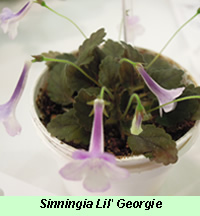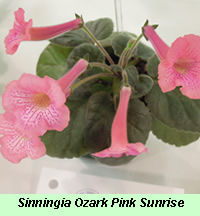Gesneriad Information
SINNINGIA
 The genus Sinningia (sin-IN-jee-a) is the second most popular genus in the Gesneriad Family. The genus Sinningia Was named for Wilhelm Sinning (1792-1874). Sinning was a horticulturist of the Royal Agricultural College in Bonn, Germany.
The genus Sinningia (sin-IN-jee-a) is the second most popular genus in the Gesneriad Family. The genus Sinningia Was named for Wilhelm Sinning (1792-1874). Sinning was a horticulturist of the Royal Agricultural College in Bonn, Germany.Sinningias have tuberous roots. A tuber is a thickened fleshy underground stem like the potato. The two most popular Sinningias are the florist gloxinia (Sinningia speciosa) and the miniature Sinningias.
The florist gloxinia was popular long before the African Violet was discovered in 1892. Gloxinias were introduced into cultivation in 1817. The flowers on the original S. spectosa were slipper shaped like the miniature Sinningias. A peloric mutation arose resulting in the upright bell shaped flower of the florist gloxinia. Top and leaf cuttings can be used to propagate florist gloxinias.
 The miniature Sinningias are very popular with the African Violet growers. It is often their first introduction to the gesneriad family. Miniature Sinningias with rosettes of leaves are under 6 inches in diameter. Cultural conditions for the miniature Sinningias is the same as an African Violet making them ideal companions for the light garden or a windowsill. Unlike the gloxinia they rarely go dormant. About the time the plant has finished blooming and is dying back another plant is sprouting from the tuber.
The miniature Sinningias are very popular with the African Violet growers. It is often their first introduction to the gesneriad family. Miniature Sinningias with rosettes of leaves are under 6 inches in diameter. Cultural conditions for the miniature Sinningias is the same as an African Violet making them ideal companions for the light garden or a windowsill. Unlike the gloxinia they rarely go dormant. About the time the plant has finished blooming and is dying back another plant is sprouting from the tuber. Simply cut off the old plant and let the new one grow up and bloom. The old plant can be rooted. Tip cuttings are a good way to propagate miniature Sinningias.
All Sinningias do well in a soilless mix consisting of 2 parts Jiffy Mix (one part peat moss to one part vermiculite) to one part perlite. Every time you water use 1/4 teaspoon to a gallon of granular fertilizer such as Rapid Gro. When the tubers go dormant knock them out of the pot and store them in a bag of vermiculite until they sprout.
